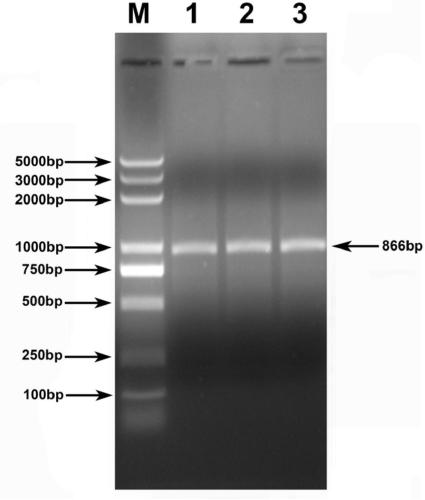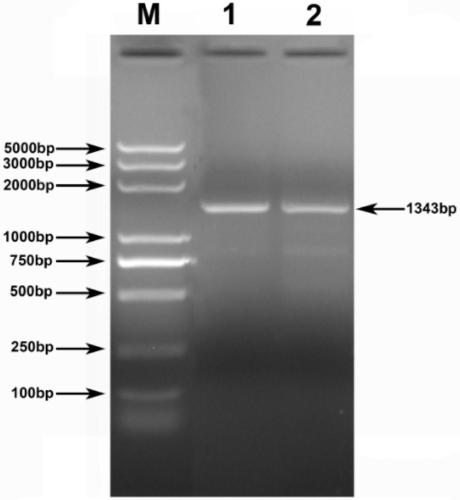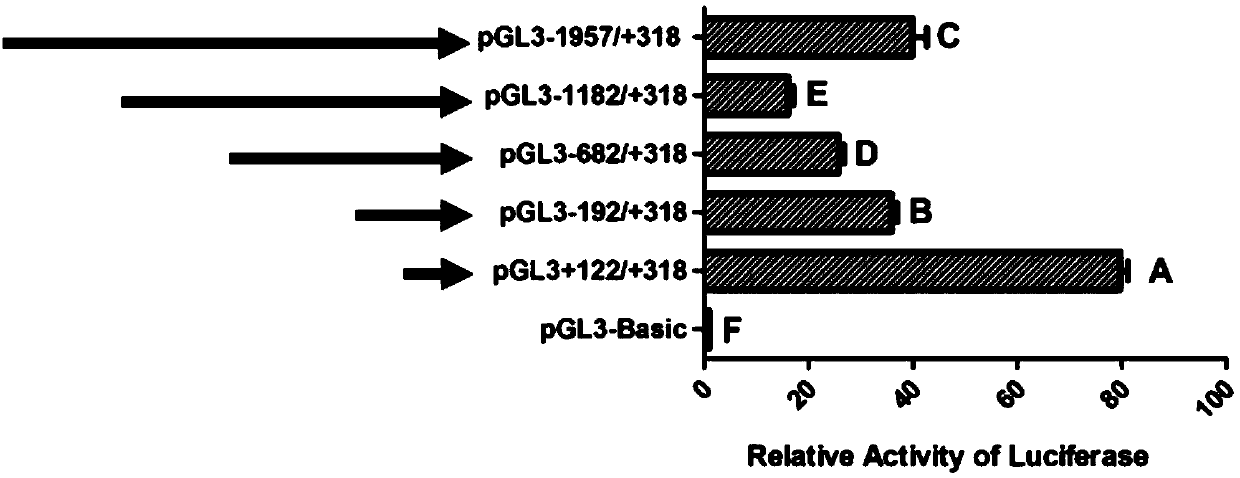Molecular cloning of meat quality trait related gene Prox1 (Prospero-related homeobox protein 1) of pigs and application
A gene and production trait technology, applied in the field of livestock molecular biology technology and genetic breeding, can solve the problems of high cost and slow genetic progress.
- Summary
- Abstract
- Description
- Claims
- Application Information
AI Technical Summary
Problems solved by technology
Method used
Image
Examples
Embodiment 1
[0031] Embodiment 1: Cloning the full-length cDNA nucleotide sequence of pig Prox1 gene
[0032] 1.1. Primer design
[0033] Using the porcine Prox1 gene mRNA sequence (NM_001128490.1) predicted in the NCBI database (https: / / www.ncbi.nlm.nih.gov / ) as the seed sequence SEQ ID NO: 1 as a template to design amplification primers, in which 5 '-RACE-specific primers (GSPs) should meet the length of 23–28nt, GC content between 50–70%, and Universal PrimerMix ( The general primers designed by the RACE 5' / 3'Kit kit include Long Primer and Short Primer) whose 3' ends are not complementary, etc., and two primers are designed to meet the above conditions, namely GSP1 and NGSP1. GATTACGCCAAGCTT was added to the 5' end to facilitate vector ligation and sequencing in subsequent experiments. The design of the 3'-RACE-specific primers of Prox1 gene was similar to that of the 5'-RACE-specific primers. The designed primers were named GSP2 and NGSP2 respectively, and GATTACGCCAAGCTT was added ...
Embodiment 2
[0044] Example 2: Cloning and activity identification of the proximal promoter region of pig Prox1 gene
[0045] 2.1 Cloning of the proximal promoter region of the porcine Prox1 gene and construction of the deletion expression vector
[0046] (1) Retrieve the genome sequence containing the porcine Prox1 gene (NCBI Reference Sequence: NC_010451.3) from the NCBI database (https: / / www.ncbi.nlm.nih.gov / ) Sscrofa10.2 version, combined with 5'RACE Prox1 5'UTR sequence, the 1957bp DNA fragment before the transcription start site T is used as the potential promoter region of Prox1 gene.
[0047] (2) Using the sequence downloaded from the database as a template, 5 pairs of promoter primers with different lengths were designed, and the 5 5' deletion fragments shared the same downstream primer, which was named PR. The upstream primers were named as P1F, P2F, P3F, P4F and P5F respectively. The 5 pairs of primers designed are shown in Table 2. The PCR reaction system: about 200 ng of DNA ...
preparation example 3
[0074] Preparation Example 3: Analysis of Porcine Prox1 Gene Expression Pattern
[0075] To determine the potential relationship between Prox1 expression patterns and skeletal muscle fiber types, we randomly selected three Duroc×Meishan binary hybrid pigs, and collected heart, liver, spleen, kidney, fat, and bones of two different muscle fiber types Muscle tissue biceps femoris (white muscle) and soleus muscle (red muscle). Utilize TRIzol reagent to carry out the extraction of total RNA (Invitrogen company product), utilize Prime Script TM The reagent was used to synthesize the first strand of cDNA (product of TaKaRa Company), and then the expression level of Prxo1 gene was detected by Real-time PCR. Based on the cloned full-length cDNA nucleotide sequence of the porcine Prox1 gene SEQ ID NO: 4 as a reference, Real-time PCR primers were designed, and the quantitative upstream and downstream primer sequences were Prox1-F: CCGTTTCAGAGTCCGTTAGGT; Prox1-R: TGGTGGGATGACATCTTGGTC, ...
PUM
 Login to View More
Login to View More Abstract
Description
Claims
Application Information
 Login to View More
Login to View More - R&D
- Intellectual Property
- Life Sciences
- Materials
- Tech Scout
- Unparalleled Data Quality
- Higher Quality Content
- 60% Fewer Hallucinations
Browse by: Latest US Patents, China's latest patents, Technical Efficacy Thesaurus, Application Domain, Technology Topic, Popular Technical Reports.
© 2025 PatSnap. All rights reserved.Legal|Privacy policy|Modern Slavery Act Transparency Statement|Sitemap|About US| Contact US: help@patsnap.com



